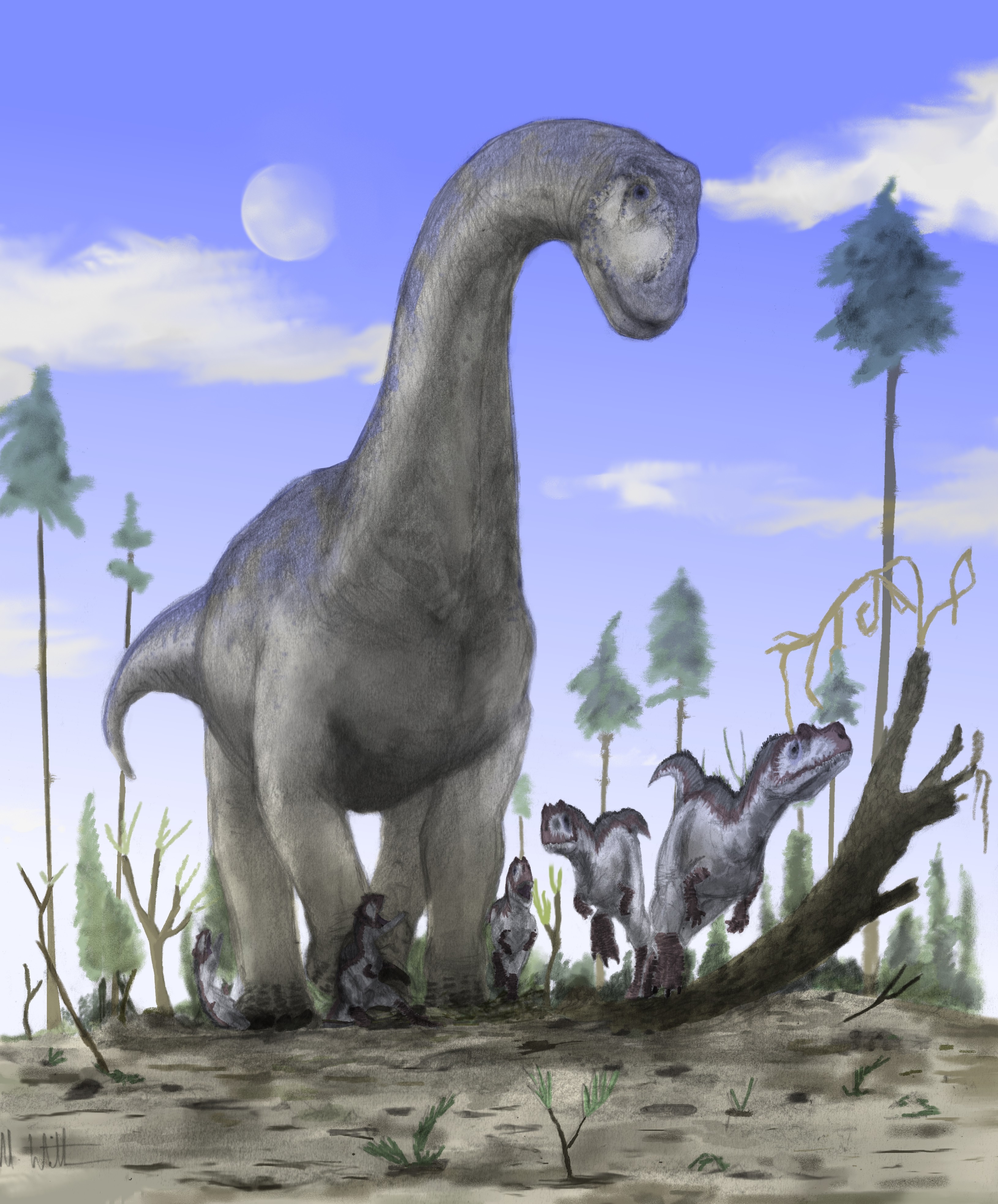
Sauropods are a suborder of the Dinosauria, a
vast group of reptiles that dominated terrestrial
environments during the Mesozoic (245 to 66
million years ago). Dinosaurs ("terrible reptiles")
are characterized by erect limbs and a pelvis that
incorporates at least five vertebrae, characteristics
that are related to their active lifestyle. Dinosaurs
are divided into two major groups based on the
structure of the pelvis. In the Saurischia ("lizardhipped"),
the pubis points forward, while in the
Ornithischia ("bird-hipped"), the pubis has
swung backward to lie parallel to the ischium. The
Saurischia includes the carnivorous dinosaurs, or
theropods, as well as the herbivorous sauropods
("lizard-foot"), the largest land animals that have
ever existed.
Systematics and Anatomy
The earliest dinosaurs are known from the late
Middle Triassic (220 million years ago) of South
America, but the earliest sauropods do not appear
until somewhat later, in the Early Jurassic. Sauropods
are most closely related to the prosauropods,
a group that originated in the Late Triassic and
consisted of large, heavily built herbivores that reverted
to the quarupedal locomotion of their dinosaur
ancestors. Although it has been suggested
that prosauropods were carnivores or omnivores,
their teeth are coarsely serrate and numerous and
were clearly adapted for shredding coarse vegetation.
They were probably adapted as the first high
browsers, capable of reaching up to high foliage to
feed.
The earliest sauropods occur in the Early Jurassic
of Africa and Asia, and from then on are a feature
of dinosaurian faunas worldwide until the
end of the Cretaceous, when the dinosaurs became
extinct. All sauropods were quadrupedal
and most were very large. The head was small and
lightly built and contained peglike or spoonshaped
teeth that were confined to the front of the
mouth, and nostrils that were placed on the top of
the head. The neck was long and consisted of up to
fifteen vertebrae, which although large were penetrated
by many openings, so that they were constructed
of struts and laminae providing maximum
strength for minimum weight. The tail is
also very long, perhaps up to seventy feet in
Seismosaurus, and contained up to eighty vertebrae,
of which the last forty were reduced to simple
rods of bone that formed a whiplash. The
limbs and girdles were massively constructed to
support the enormous weight of these animals
and the feet were broad and elephant-like, with
the animal standing on the tips of its toes like all
dinosaurs.
Several main groups are recognized-the
diplodocids, the camarasaurids, and the brachiosaurids-
but there are other, more poorly known
sauropods, particularly at the beginning of sauropod
evolution, that do not fit into these groups.
The earliest sauropods come from Zimbabwe and
are very similar to the prosauropods. Following
these are Chinese forms fromthe Early Jurassic, in
which weight-bearing features, such as shortening
of the fingers and toes, become more apparent.
In addition, teeth become restricted to the front
portion of the jaws only. Sauropods had become
diverse and widespread by the Middle Jurassic,
but it is not until the Late Jurassic that they became
common in North America. At this point, the
three main groups are well represented and they
remain abundant into the early part of the Cretaceous.
One of the best known diplodocids is Diplodocus,
which is represented by a number of skeletons
collected from the western United States. A
related form is Apatosaurus, which for a long time
was incorrectly known as Brontosaurus due to
confusion caused by initial descriptions based on
incomplete material. These animals were characterized
by a protruding muzzle and small, pencillike
teeth restricted to the front of the jaws. The tail
was very long, with more than eighty vertebrae
present in some species. The fore limbs are considerably
shorter than the hind limbs, so that the hip
was high compared to the shoulder. Brachiosaurs
and camarosaurs were contemporaries of the
diplodocids. Brachiosaurus ("arm-lizard") is particularly
well known frommaterial collected from
Tendaguru in Tanzania by German expeditions
between 1908 and 1912. The very fine articulated
skeleton mounted in the Humboldt Museum in
Berlin stands 12 meters tall and is almost 22.5 meters
long, and shows the relatively short tail and
very long front limbs that are characteristic of this
group. In addition, the head of brachiosaurs is
more compact than that of diplodocids and the
jaws are lined with large, chisel-shaped teeth. The
camarosaurs, such as Camarosaurus ("chambered
reptile"), were similar in many ways to the brachiosaurs,
and like them had compact skulls, with
large, chisel-shaped teeth in the jaws, although
the muzzle was shorter. Camarosaurus had a much
shorter neck, however, and the front limbs were
shorter than the hind limbs, as in the diplodocids,
so that the hips and shoulders were at about the
same level.
For unknown reasons the sauropods almost
perished at the end of the Jurassic, and there are
only a few species known from the Cretaceous, although
they were present throughout the period.
The last survivors are members of a group known
as the titanosaurids, which are widespread but
known only from incomplete material. One of the
interesting features of this group is that they bore
bony armor that consisted of large bony plates
scattered across the back with masses of small
nodules in the hide between them. No other
sauropods are known to have possessed armor.
Lifestyle
Sauropods were originally thought to have been
aquatic animals, as it was considered that their
large size would have precluded a terrestrial existence
and that the long neck and nostrils on top
of the head would have enabled them to reach
the surface to breathe. However, it is now considered
that sauropods lived a terrestrial lifestyle
similar to that of modern elephants. Several
features of the skeleton support this view. In particular,
weight-reducing features, such as the
openings developed in the vertebrae of the neck
and tail, are adaptations associated with living on
land where bodily support under the effects of
gravity is critical in large animals. In addition, the
presence of clefts in the top of neural spines on
the neck vertebrae provides evidence of the presence
of thick, ropelike ligaments that ran from
the shoulders along the neck and allowed it to
be held clear of the ground effortlessly. A similar
feature is seen in the tail, indicating that it also
was held horizontally, and this is supported by the
evidence of tracks which only rarely show a taildrag
mark.
Trackways provide evidence that sauropods
probably moved around in small groups, possibly
up to twenty individuals. Although adults were
probably big enough to have been immune to attack
by large theropods, juveniles might have
needed the protection that herding behavior
would have given them. Studies of trackways
have also shown that they would have moved
slowly, perhaps at no more than four miles per
hour, and that it would not have been possible for
them to run. In all probability, they moved slowly
from one stand of conifers to another, browsing
high up in the trees.
As they had only small, weak teeth at the
front of the mouth and no chewing teeth, it was
originally thought that they fed on soft aquatic
vegetation. However, stomach contents show that
they fed on resistant conifers, and it is now thought
that they stripped vegetation from branches
and then passed it down to a gizzard, probably
lined with stones, that would have processed
the vegetation. The dwindling of conifers through
the Cretaceous has been suggested as a cause
of the decline of the sauropods during the same
period.
The Size of Sauropods
Although sauropods were clearly the largest land
animals that ever existed, it has been difficult to
estimate the length and mass of particular species
because this has to be based on reconstructions of
skeletons and soft tissue estimates. The tallest
sauropod seems to have been Brachiosaurus, as the
head of the Berlin specimen is twelve meters
above ground level. Other sauropods have a different
build, and the neck was probably oriented
more horizontally. Calculations of masses of
sauropods are particularly difficult, as the amount
of soft tissue probably varied for individuals depending
on age, health, and even from season to
season. Apatosaurus may have weighed between
thirty and forty tons and Brachiosaurus thirty to
ninety tons; however, some poorly known sauropods,
such as Supersaurus and Ultrasaurus, may
have been heavier. The record for the longest
sauropod was long held by a specimen of
Diplodocus, at 87 feet, but extrapolations of length
from partial material suggest that Seismosaurus
mayhave been as much as 150 feet long. Great size
may have been a metabolic advantage for sauropods.
As very large animals lose heat slowly, due
to their relatively small surface area, they probably
operated as gigantotherms, requiring only a
small food intake to maintain their internal temperature.
Sauropod Facts
Classification:
Kingdom: Animalia
Subkingdom: Bilateria
Phylum: Chordata
Subphylum: Vertebrata
Class: Reptilia
Order: Saurischia
Suborder: Sauropoda
Geographical location: Every continent except
Antarctica
Habitat: Terrestrial habitats
Gestational period: Unknown
Life span: Estimated at fifty years
Special anatomy: Very large quadrupedal dinosaurs
in which the head was small, the neck
and tail long
Other popular Animals
Photo Gallery of - Sauropod
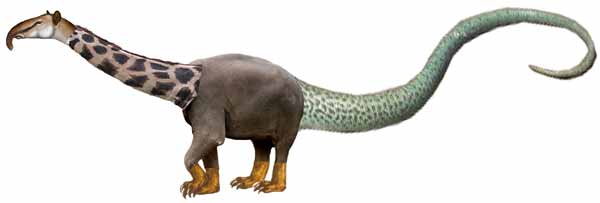
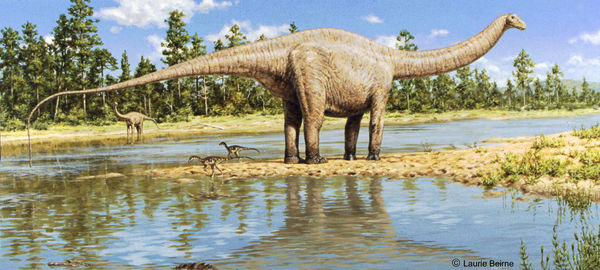

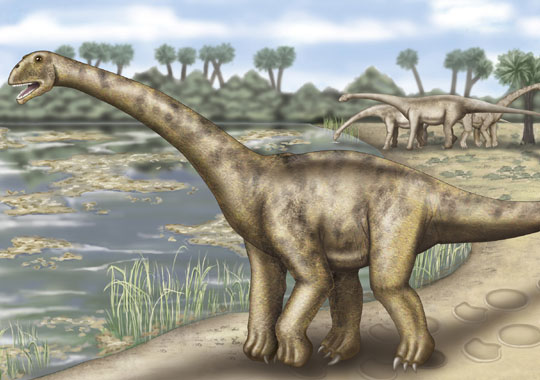
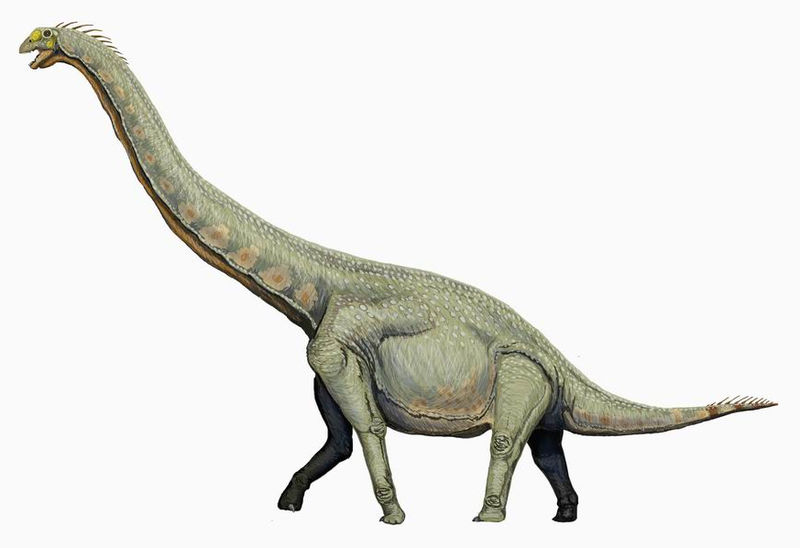
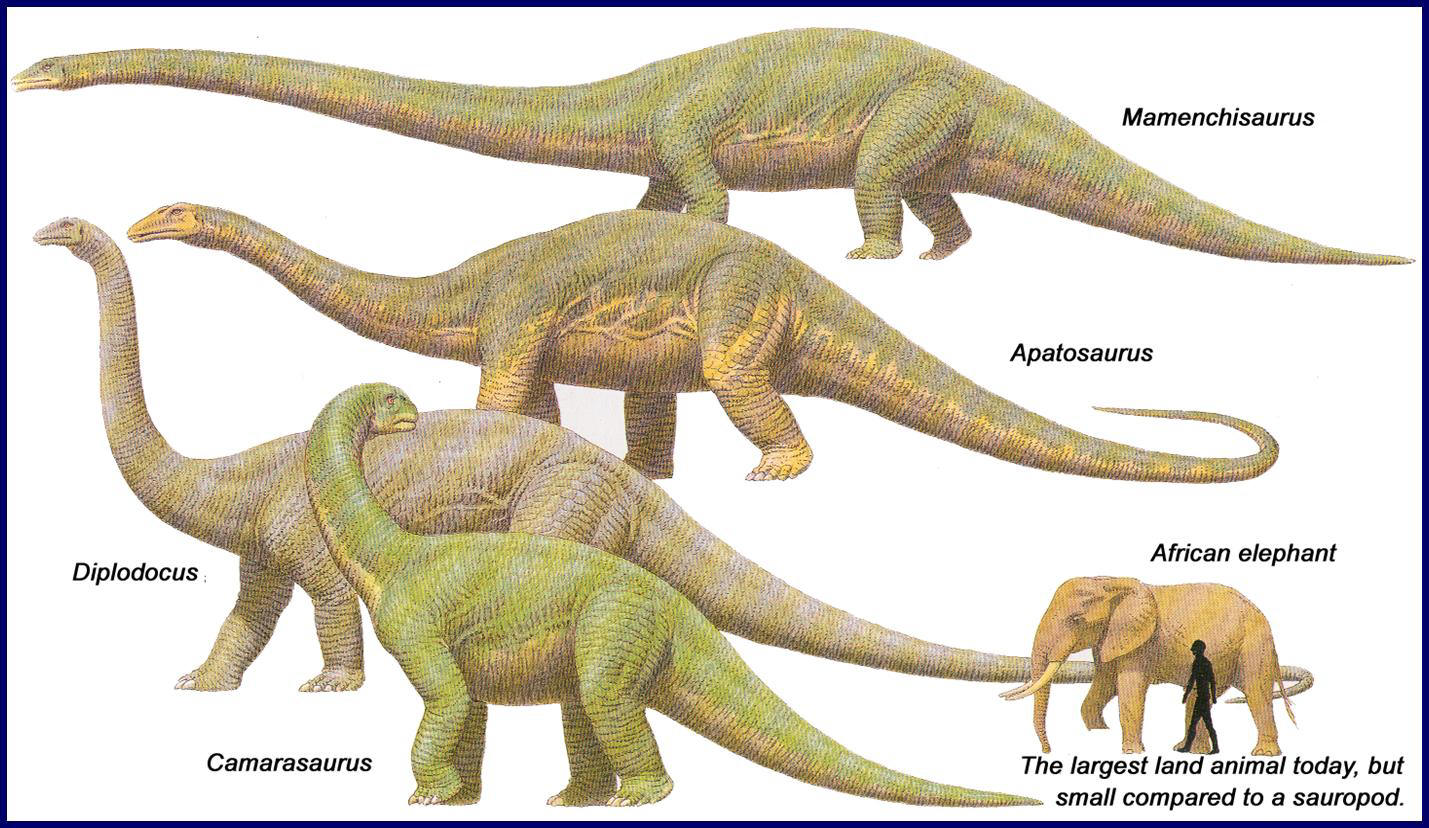
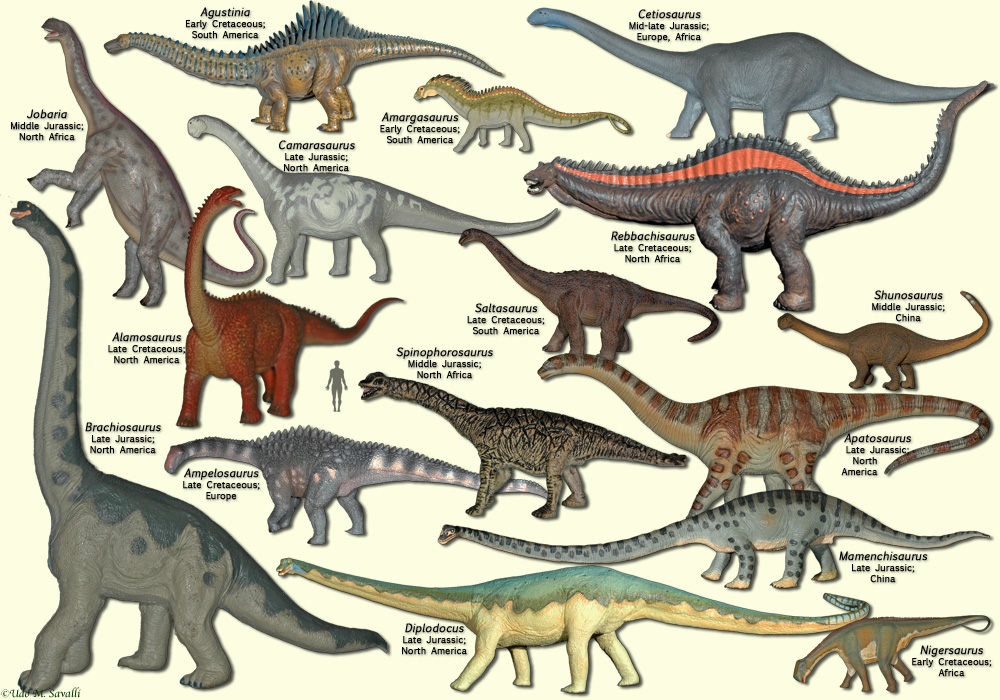

 Animalia Life
Animalia Life